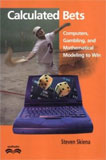262 pages
List Price: $26.16
Buy new:
$26.16
Calculated Bets
by Steven Skiena, Ronald Graham (Series Editor), John Barrow (Series Editor), Fan Chung (Series Editor), Ingrid Daubechies (Series Editor), Persi Diaconis (Series Editor), Don Zagier (Series Editor)
Customer Reviews
Mathematical modeling done right, December 29, 2002
Reviewer: A reader
To knowledge seekers, the ability to understand and beat a system is the entire game. In this book, Skiena describes how he and some of his students wrote a computer program to win money betting on professional jai alai matches. Along the way, he explains the origins of the game and some of the basic rules, the fundamental bets that can be made as well as the meaning of statements such as pari-mutuel betting. His program does work well, in that he quadruples his money in a short time. Once that is done, he gives the money to a university charity, hoping to make his money from writing this book.
The fact that such a program could be created is not surprising. Jai-alai is a sport where individuals compete one-on-one or in teams of two, and the betting patterns determine the payoffs. It is much easier to simulate these types of matchups and predict the outcome than it is for team games. Baseball managers have been doing such modeling for years. If my memory serves me correctly, the first to do it in major league baseball was Davey Johnson, who kept detailed statistics on all pitcher-batter matchups. All of his decisions concerning who to put up to bat were then based on playing the percentages. That is essentially what Skiena does, although with a different twist. Pari-mutuel betting is where those who wager are betting against each other, so the patterns of wagering determine the payoffs. The patterns of betting are also factored into his predictions. These conditions make it possible for someone to make money creating such a system, but only as long as no one else is doing it. If others begin to use
the same system, then the players are betting against each other, destroying the opportunity to make a profit. Therefore, his very act of publishing this book probably means that his system can no longer be used to win at jai-alai betting.
This is an excellent example of how basic mathematical modeling is done. Use data of previous results to form a model of what has happened in order to predict what will happen. Skiena writes with a wit and rigor that is rarely seen in mathematics. Very little mathematics background is needed in order to understand the explanations of the behavior of the program and why it works.
I found this book so interesting that I stayed up very late finishing it. It reads like a novel, but teaches you a lot about mathematics. Instructors in mathematical modeling and computer programming can find many interesting ideas for classroom exercises in it. As long as no one takes it too seriously, it is all in good, clean fun.


|



